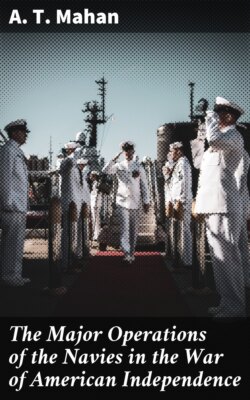Читать книгу The Major Operations of the Navies in the War of American Independence - A. T. Mahan - Страница 26
На сайте Литреса книга снята с продажи.
THE NAVAL CAMPAIGN ON LAKE CHAMPLAIN
1775–1776
ОглавлениеTable of Contents
At the time when hostilities began between Great Britain and her American Colonies, the fact was realised generally, being evident to reason and taught by experience, that control of the water, both ocean and inland, would have a preponderant effect upon the contest. It was clear to reason, for there was a long seaboard with numerous interior navigable watercourses, and at the same time scanty and indifferent communications by land. Critical portions of the territory involved were yet an unimproved wilderness. Experience, the rude but efficient schoolmaster of that large portion of mankind which gains knowledge only by hard knocks, had confirmed through the preceding French wars the inferences of the thoughtful. Therefore, conscious of the great superiority of the British Navy, which, however, had not then attained the unchallenged supremacy of a later day, the American leaders early sought the alliance of the Bourbon kingdoms, France and Spain, the hereditary enemies of Great Britain. There alone could be found the counterpoise to a power which, if unchecked, must ultimately prevail.
Nearly three years elapsed before the Colonists accomplished this object, by giving a demonstration of their strength in the enforced surrender of Burgoyne's army at Saratoga. This event has merited the epithet "decisive," because, and only because, it decided the intervention of France. It may be affirmed, with little hesitation, that this victory of the colonists was directly the result of naval force—that of the colonists themselves. It was the cause that naval force from abroad, entering into the contest, transformed it from a local to a universal war, and assured the independence of the Colonies. That the Americans were strong enough to impose the capitulation of Saratoga, was due to the invaluable year of delay secured to them by their little navy on Lake Champlain, created by the indomitable energy, and handled with the indomitable courage, of the traitor, Benedict Arnold. That the war spread from America to Europe, from the English Channel to the Baltic, from the Bay of Biscay to the Mediterranean, from the West Indies to the Mississippi, and ultimately involved the waters of the remote peninsula of Hindustan, is traceable, through Saratoga, to the rude flotilla which in 1776 anticipated its enemy in the possession of Lake Champlain. The events which thus culminated merit therefore a clearer understanding, and a fuller treatment, than their intrinsic importance and petty scale would justify otherwise.
In 1775, only fifteen years had elapsed since the expulsion of the French from the North American continent. The concentration of their power, during its continuance, in the valley of the St. Lawrence, had given direction to the local conflict, and had impressed upon men's minds the importance of Lake Champlain, of its tributary Lake George, and of the Hudson River, as forming a consecutive, though not continuous, water line of communications from the St. Lawrence to New York. The strength of Canada against attack by land lay in its remoteness, in the wilderness to be traversed before it was reached, and in the strength of the line of the St. Lawrence, with the fortified posts of Montreal and Quebec on its northern bank. The wilderness, it is true, interposed its passive resistance to attacks from Canada as well as to attacks upon it; but when it had been traversed, there were to the southward no such strong natural positions confronting the assailant. Attacks from the south fell upon the front, or at best upon the flank, of the line of the St. Lawrence. Attacks from Canada took New York and its dependencies in the rear.
